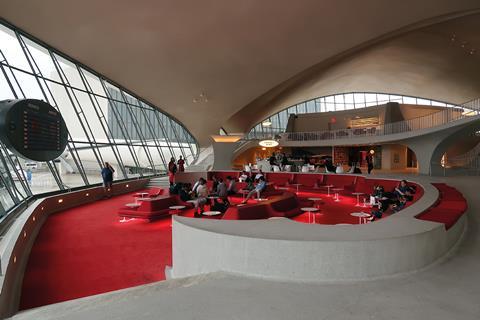- News

All the latest updates on building safety reformRegulations latest
- Focus
- Home
- News
- Focus
- Comment
- Events
- CPD
- Building the Future
- Jobs
- Data
- Subscribe
- Building Boardroom
A wing and a prayer: what future for airport terminals?
By Ike Ijeh2020-06-01T05:00:00

Some of the most iconic architecture of our time has been in the form of airport terminals, but if covid-19’s devastating effect on aviation proves permanent, will these structures become redundant? Ike Ijeh surveys aviation’s architectural gems and ponders their future

The TWA Hotel, converted from Eero Saarinen’s iconic terminal building in New York.
Source: Shutterstock
In our modern world of continual scientific advances, there is one area in which we as a civilisation have regressed in technological terms over the past three decades: aviation. In 1996 Concorde flew from New York to London in just 2 hours 52 minutes, but Concorde’s 2003 decommissioning means the average flight time between New York and London today is around 8.5 hours, almost three times as long – and about an hour longer than it would have taken in the early 1960s, as a result of higher fuel prices and increasingly congested airports.
If aviation does represent a curious cessation of progress in the modern world, the onset of the global coronavirus pandemic can only make things worse. Global aviation has been brought to a virtual standstill by the pandemic, causing the collapse into administration of airlines such as Virgin Australia, with many more at risk. Even when lockdowns are eased and planes fly again, aviation is still likely to be in perilous territory.
We take a look at some of the landmarks of global airport architecture and try to unearth any clues they offer as to how air terminals might be converted to new uses in a post-covid world.
Read more …
Already registered? Login here
To continue enjoying Building.co.uk, sign up for free guest access
Existing subscriber? LOGIN
Stay at the forefront of thought leadership with news and analysis from award-winning journalists. Enjoy company features, CEO interviews, architectural reviews, technical project know-how and the latest innovations.
- Limited access to building.co.uk
- Breaking industry news as it happens
- Breaking, daily and weekly e-newsletters
Get your free guest access SIGN UP TODAY

Subscribe now for unlimited access
Subscribe to Building today and you will benefit from:
- Unlimited access to all stories including expert analysis and comment from industry leaders
- Our league tables, cost models and economics data
- Our online archive of over 10,000 articles
- Building magazine digital editions
- Building magazine print editions
- Printed/digital supplements
Subscribe now for unlimited access.
View our subscription options and join our community


















